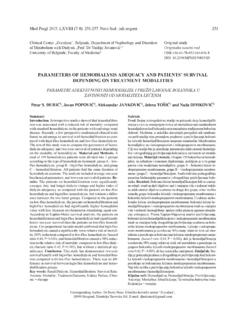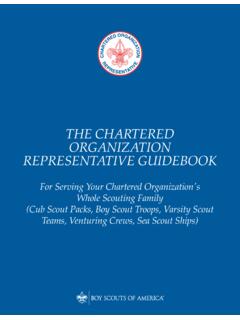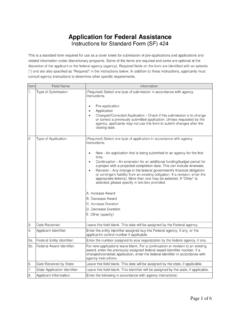Transcription of Nebojša Janićijević* - doiSerbia
1 ECONOMIC ANNALS, Volume LVIII, No. 198 / July September 2013. UDC: ISSN: 0013-3264. Neboj a Jani ijevi *. THE MUTUAL IMPACT OF ORGANIZATIONAL. CULTURE AND structure . ABSTRACT: This paper explores the or changing of organizational culture is relationship between the structure and explained at the conceptual level. Then, culture of an organization . The starting based on the known classifications of assumption is that organizational structure organizational structure and culture, and organizational culture impact each they are put into a relationship of direct other, and that there is a causal relationship mutual interdependence. This is done by due to which the agreement of the two generating hypotheses about the agreement components of organization leads to better of particular types of organizational culture performance. First, the mechanism through and particular types of organizational which organizational culture impacts the structure . design of organizational structures and the manner in which organizational structure KEY WORDS: organization , organiza- affects the maintenance, strengthening, tional structure , organizational culture JEL CLASSIFICATION: M10, M14.
2 * University of Belgrade, Faculty of Economics, Serbia, E-mail: jnebojsa@eunet 35. Economic Annals, Volume LVIII, No. 198 / July September 2013. 1. Introduction Organizational structure and organizational culture belong among the concepts with the highest explanatory and predictive power in understanding the causes and forms of people's behaviours in organizations. Consequently, these two concepts are often used in research as independent variables in explanations of numerous phenomena found in companies and other types of organizations. The influences of organizational structure and culture on other components of management are usually researched separately and independently from one another. However, there are examples of research that analyzes the influence on management of both culture and structure in their mutual interaction (Wei, Liu, Herndon, 2011; Singh, 2011; Zheng, Yang, McLean, 2010). Unfortunately, although it is intuitively clear that organizational culture and organizational structure must greatly impact one another, there has been very little extensive research exploring their direct mutual impact.
3 Exploring the relationship between organizational structure and culture would be highly beneficial, since both of them determine the behaviour of organization members. However they do it in different ways. Organizational culture is an intrinsic factor of organizational behaviour, inasmuch as it directs the way people behave in an organization by operating from within and by determining assumptions, values, norms, and attitudes according to which organization members guide themselves in everyday actions in the organization . On the other hand, organizational structure is an extrinsic factor which influences people's behaviour from the outside, through formal limitations set by division of labour, authority distribution, grouping of units, and coordination. Therefore one's behaviour in an organization is the result of the impact of its culture and structure , as well as the influence of other factors. Therefore studying the mutual impact of organizational culture and structure is important for a comprehensive understanding of the behaviour of an organization 's members.
4 Organizational culture can be defined as a system of assumptions, values, norms, and attitudes, manifested through symbols which the members of an organization have developed and adopted through mutual experience and which help them determine the meaning of the world around them and the way they behave in it (Jani ijevi , 2011: 72). As this definition implies, organizational culture has a cognitive and a symbolic component in its content. The cognitive component consists of mutual assumptions, beliefs, norms, and attitudes that the organization 's members share, and which also shape their mental (interpretative). schemes (Alvesson, 2002; Martin, 2002; Smircich, 1983). Organizational culture 36. Organizational culture and structure therefore determines the way the organization members perceive and interpret the surrounding world, as well as the way they behave in it. The cognitive content of organizational culture ensures a unique manner of assigning meaning and a unique reaction to phenomena within and around the organization .
5 Hence, if a strong culture exists in an organization , all the members of the organization will make decisions, take actions, or enter interactions in a similar and foreseeable fashion. Symbols are a visible part of organizational culture, and they manifest its cognitive component. Semantic, behavioural, and material symbols strengthen, transmit, and also modify organizational culture (Alvesson, Borg, 1992;. Dandridge, Mitroff, Joyce, 1980). The significance of organizational culture emerges from the fact that, by imposing a set of assumptions and values, it creates a frame of reference for the perceptions, interpretations, and actions of the organization 's members (Schein, 2004). In this way it influences all the processes that take place in an organization , and even its performance. Through managers' and employees' mental maps, organizational culture influences the dominant leadership style, organizational learning and knowledge management, company strategy, and also the preferred style of changing the management, employee reward system, commitment, and other aspects of connections between individuals and the organization .
6 It would, therefore, be rational to assume, as this paper initially postulates, that organizational culture impacts on a company's organizational structure . With its assumptions, values, and norms, the culture influences top management's frame of reference that shapes organizational structure . Organizational structure is, therefore, a sort of cultural symbol and it mirrors key assumptions and values dominant in an organization . Organizational structure is defined as a relatively stable, either planned or spontaneous, pattern of actions and interactions that organization members undertake for the purpose of achieving the organization 's goals. This understanding of organizational structure is based on a fundamental assumption of it being purposeful, , on the idea that organizational structure has its purpose (Dow, 1988). Purposefulness of structure implies that it is a rational instrument in the hands of those governing the organization , used for directing the course of activities in the organization towards realizing its objectives.
7 Rationality of the organizational structure is ensured by its differentiation and integration of organization members' individual and collective activities (Lawrence, Lorsh, 1967). The differentiation process involves differentiation of operational and managerial activities. Differentiation of operational activities is realized through division of labour, or in other words, job design, and it results 37. Economic Annals, Volume LVIII, No. 198 / July September 2013. in the organization 's specialization level. Differentiation of managerial activities determines who decides on what, and results in a certain level of centralization or decentralization of authority within the organization . Integration is realized in unit grouping and coordination. Unit grouping, or departmentalization, implies structuring of activities and tasks into organizational units, and it can be based on input (functional), output (market or project), or a combination of the two (matrix).
8 Individual and group activities and tasks in an organization are harmonized by coordination, in order for it to function as a unified whole. Coordination can be achieved through five basic mechanisms: direct supervision, mutual communication, process standardization, output standardization, and knowledge standardization (Mintzberg, 1979). Differentiation and integration in organizational structuring therefore imply four essential dimensions of organizational structure : job design, delegation of authority, unit grouping, and coordination. These dimensions of organizational structure are congruent, which means that there is harmony or concordance between them. Presumption of congruency is fundamental for the concept of organizational structuring (Miller, 1990; Mintzberg, Miller, 1984; Mintzberg, 1979). It assumes that congruency or harmony as dimensions of the organizational structure leads to better performance of the organization . In order for an organization to be successful it has to provide mutual congruency of the dimensions of its own organizational structures.
9 This, then, leads to the formation of configurations of congruent structural dimensions, which is just a different name for models of organizational structure . An organizational model is actually a unique configuration of congruent structural dimensions: a certain level of specialization and (de)centralization levels, a certain unit grouping mode, and a certain coordination mechanism. The most prominent classification of models of organizational structure as configurations of structural dimensions has been provided by Mintzberg, (Mintzberg, 1979), and it will be used in this paper. Organizational structure models, as a particular configuration of structural dimensions, direct and shape the manner in which organization members perform their tasks in the course of achieving the organization 's goals. In different organizational models the organization members make decisions, take actions, and interact within the organization 's functioning in entirely different ways.
10 Thus it can be assumed that the model of the organizational structure influences organizational culture. It is quite possible that the compatibility of the behaviour determined by the structural framework in an organization , on the one hand, and the behaviour determined by cultural assumptions and values, on the other hand, has an impact on strength, , in strengthening or weakening of organizational culture. 38. Organizational culture and structure Based on the understanding of organizational culture and structure , a causality of their relationship, or rather their mutual influence, can be postulated as a reasonable presumption. It can also be assumed that the compatibility of organizational culture and structure would have a positive impact on an organization 's performance. This paper's goal is to explain the mechanism of mutual influence between organizational culture and structure , but also to operationalize the said relation through developing hypotheses on the compatibility of particular types of organizational culture and particular models of organizational structure .














